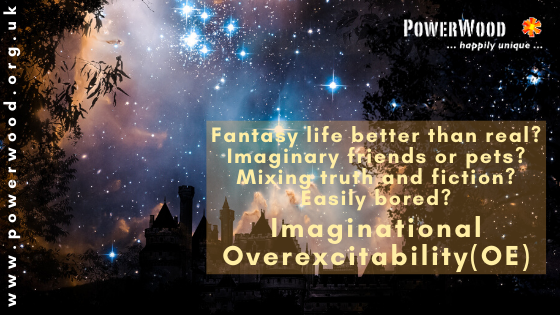
Exploring OverExcitability – E-Book FREE when a member, read about:
- How having OE might affect yourself and/or your child.
- Where this behaviour stems from.
- How it can be misdiagnosed.
- What the strengths are of having Overexcitability.
Imaginational OE
 Children with an imaginational OE have a rich imaginative life which they often prefer to reality. When introverted they can be completely content to focus on their own inner world and if an extrovert they might focus on engaging others in their dramatic ideas, painting the imaginary world they live in.
Children with an imaginational OE have a rich imaginative life which they often prefer to reality. When introverted they can be completely content to focus on their own inner world and if an extrovert they might focus on engaging others in their dramatic ideas, painting the imaginary world they live in.
They often have or had an imaginary friend, talk and share with their pets, create complex games or plays, love to daydream extensively, are magical thinkers and can be very dramatic. Children might mix truth and fiction, have a high need for stimulation and are easily bored.
Mostly they are visual-spatial learners. At a certain moment they just ‘get’ something, often being unable to explain how they got there. They have a very detailed visual memory, which they can easily access and are great at seeing creative new connections between different realms.
“My son, 5 years old at the time, was taking apart our old washing machine beside the house. He was happy tinkering and finding our how it had all been connected. Several weeks later it was my birthday and I received from him a wildly wrapped brithday present, indicating it was something he had made himself. I opened the present and it was a beautiful glass salad bowl. We were surprised about where he had got such a beautiful gift. Proudly he explained it was the glass door of the old washing machine.” Simone
Unfortunately, when they are emotionally tense they can also use this creative force to create a bleak and scary imaginative world.
If these children also have emotional OE their imagination becomes very real. They not only fantasise but feel as if it is actually happening, which can create immense emotional upsets. They might worry about what will happen when a parent dies or when they won’t be able to fulfil expectations and even how they will remember to do their homework correctly, triggering their fear of the unknown.
Often it is not easy for them to relax and fall asleep, especially as they are prone to night terrors, nightmares and illusions. This child has the potential of being misdiagnosed with an anxiety disorder.
“Mary (8) saw her mother in her imagination, covered in blood, and was so scared she didn’t dare to go to sleep. I told her she was the boss of her imagination and that she could change the blood into anything she liked. The next time I saw her, she told me happily she had changed the blood into red balloons.” Simone
Getting their attention can be difficult. This lack of attention is frequently seen as disrespectful in a classroom setting and can be mistaken for a characteristic of ODD (Oppositional Defiant Disorder) or ADHD (Attention Deficit Hyperactivity Disorder).
Imaginational OE is great to have as all new inventions and future solutions for world problems stem from this OE. These people can also use their imagination, fantasy and detailed visualisation to create a safe space to soothe themselves, which can be a great comfort in life.
Read more about the other areas of intensity: Psychomotor, Sensual, Intellectual, Imaginational and Emotional.
PowerWood’s Community
Find understanding, tools and strategies that work in an understanding, respectful and compassionate Community.
PowerWood can be your and your families advocate and your second family.
Explore how joining our PowerWood community by becoming a member will benefit you and your family and what types of memberships are available.
Join our Community
Available to Members*
*Booking a one-off Free Introductory Talk of 45-60 minutes by Skype or FaceTime with Senior Consultant Simone de Hoogh is one of the benefits of being either a FreeBee PowerWood Community Member or a Friend PowerWood Community Member.
Book a FREE Introductory Talk with a Professional*
You can read more about PowerWood’s Consultancy Sessions, the Benefits of a Free Introductory Talk and PowerWood’s Consultancy Services Tiered Fee Structure.
*Overexcitability Test
OE (Overexcitability) is an element of a Developmental Theory –Theory of Positive Disintegration by Dabrowski- that is one of the underpinning theories of MERT (Multi-level Emotion Regulation Theory) developed by Simone de Hoogh. Overexcitability explains and allows us to look at ‘extreme’ behaviour as a valuable asset in our or our children’s life.
Find out if you or your child has OE (OverExcitability) as well
*Boundary Test
A HUGE thank YOU to the son and daughter of Ernest Hartmann’s who gave PowerWood permission to use and put the full academically approved questionnaire about the Boundary in the Mind on PowerWood’s website.
Find out how the Boundary in the Mind affects you or your child
Further Reading
UK
Lucinda Leo’s Blog: Imaginary friends and playdate meltdowns – The ups and downs of Imaginational Overexcitability
USA
Living With Intensity: Understanding the Sensitivity, Excitability and Emotional Development of Gifted Children, Adolescents, and Adults (Book edited by Daniels and Piechowski)
Jade Ann Rivera – How to identify and cope with overexcitabilities, part 2 of 5: Imaginational overexcitability
